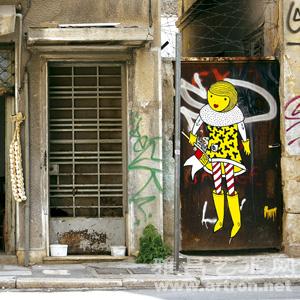 |
About 798 from the 798 web-site home page:
798 stands for
much more than a three digit number: in Beijing these numbers symbolize the
country's cutting edge art movement led by the Chinese vanguard, unchained
artistic personalities with alternative life goals. Wild and unconquered
attitudes waft inside 798's free and rambling atmosphere. This area feels a
kinship to what can be discovered and sensed along the Left Bank in Paris or
around Greenwich Village in NYC. 798 has become the biggest arts area in China and earned great international acclaim in the space of just two years.
 |
On the occasion of the Cultural Year
of Greece in China, the "Labyrinths"
exhibition aspires to bring together two
ancient civilizations through the
channel of contemporary art expression.
|
The 798 Art
District is located in the Dashanzi area, Chaoyang District, in northeastern
Beijing, past the 4th Ring Road. The large area was once a booming compound for
the State's pre-reform electronic industries. After the economy toppled these
dinosaurs the space became available and these former industrial units evolved
into the now famous Factory 798.
The buildings
were vital for China's old industrialization projects and they're just as key
to the art scene at 798 as well. Constructed with help from the now former
Soviet Union and designed by the former East German Republic, the architecture
reveals and reminds visitors about the history of New China's
industrialization, merging a free, creative spirit with the old, turgid
Communist style.
 |
| Title: Family 2008-A Artist 张晓刚 Zhang Xiaogang Gallery: Beijing Commune |
As Beijing's
economy developed after Deng Xiao Ping's reforms the structure of industry
changed; the initial mission of the 798 District withered up and died. This
industrial area quickly became desolate: businesses moved out, leaving empty
factory shells behind. Like a graveyard the place was eerily quiet and dead.
 |
| Artist:海波 Hyperion see his work here |
 |
| Light: Huang Yuxing Painting Exhibition at Star Gallery |
The 798 District
impresses visitors by the odd but harmonious combination of historical and
artistic factors... the formation of new, modern lifestyles in old spaces. Here
art is alive and real, with artists at 798 living and working in spaces in tune
with the past and the present.
 |
| Iida Yuko Red Leaves from Star Gallery |
The 798 Art
District provides creative people with an opportunity and an outlet to
enthusiastically pursue their artistic ideals. It has also given them a unique,
spiritual homeland. China's artists have truly inspired new life into an area
of Beijing, resurrecting the ghosts of the past while breathing in energy and
innovation in the present. Indeed, China's vanguard has turned an industrial
graveyard into an artistic paradise.

